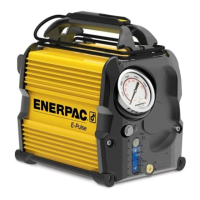14
4. Mechanically support the lowered load. Refer to Section
7.7.
5. Move the control valve lever to the “N” position.
7.7 Supporting the Load
WARNING
Failure to observe the following precautions and instructions
could allow the load to drop and/or become unsupported.
Death or serious personal injury could result if the load falls
on or crushes persons in the work area.
• After completing a lifting procedure, always immediately
support the load with cribbing, metal support stands, jack
stands, hoist or other appropriately rated mechanical load
support devices. Do not rely on the pump hydraulics to hold
lifted loads in place.
• The pump control valve does NOT contain a safety locking
valve. Never allow persons to be underneath a lifted load that
is supported only by the pump hydraulics.
• Additional flow control devices (optional accessories) may
be required to safely hold the cylinder or tool in a stationary
position as mechanical load support devices are being
installed or removed. Refer to the Enerpac catalog for
additional information.
• Although in most applications the pump hydraulics will
temporarily hold the load, be aware that a load supported only
by hydraulics can move downward or drop suddenly at any
time without warning, due to equipment failure or accidental
activation of controls.
• When pushing or separating objects, always secure the load
with appropriately rated mechanical blocking equipment
before allowing persons to reach or work inside the danger
zone between the objects. Never rely on hydraulics to hold
apart pushed or separated objects while persons are inside
the danger zone.
8.0 RELIEVING HYDRAULIC PRESSURE
Relieve hydraulic pressure before disconnecting hydraulic
hoses, loosening hydraulic fittings or performing maintenance
procedures. Refer to the following steps:
1. Be sure that the load has been completely removed from the
cylinder(s) or tool(s).
2. Be sure that the pump is o.
3. Depressurize the system:
EP3204J Models Only: Move the control valve to the “T”
position.
EP3404J Models Only: Move the control valve back and forth
between the “A”, “N” and “B” positions several times.
4. Verify that pressure has been completely relieved. All gauges
(user-supplied) must indicate zero (0) psi/bar. Hydraulic hose(s)
must not be sti. There must be no other indications of pressure
in the system.
If needed, hydraulic pressure can also be relieved
manually by turning the pump relief valve screw fully
counterclockwise to its lowest setting. Refer to Section 9.0 for
additional information.
9.0 PRESSURE RELIEF VALVE ADJUSTMENT
WARNING
Maximum pump hydraulic pressure is limited by a
mechanical stop to approximately 10,300 to 10,800 psi [710
to 745 bar]. Be certain that the relief valve pressure setting
does not exceed the maximum rated pressure of the cylinder
or tool being used. Failure to observe this precaution may
result in catastrophic failure of cylinder or tool and related
components. Death or serious personal injury could occur.
The pump contains a user-adjustable pressure relief valve that
controls system pressure. This valve is factory set at approximately
10,000 psi [700 bar]. However, the valve setting can be adjusted
by the user if needed, as described in the following procedure.
1. Be sure that pump is o and that all hydraulic pressure is
completely relieved. Refer to instructions in Section 8.0.
2. Disconnect the hydraulic hose from the pump “A” port.
3. EP3204J Models Only: Disconnect hydraulic hose from the
pump “A” port.
EP3404J Models Only: Disconnect hydraulic hoses from the
pump “A” and “B” ports.
4. Install a 0-15,000 psi [0-1035 bar] hydraulic pressure gauge in
the pump “A” port. See Figure 10.
5. EP3404J Models Only: Install a 3/8" NPTF pipe plug in the
pump “B” port. Tighten until finger tight. Then tighten an
additional 1.5 to 3.0 turns or torque to 40 ft. lb [54.2 Nm].
Refer to Figures 6 and 7 for control valve lever positions.
6. EP3204J Models Only: Move the control valve lever to the
“T” position.
EP3404J Models Only: Move the control valve lever to the
“N” position.
Use only a flat blade screwdriver of appropriate size to
adjust the relief valve pressure. The relief valve screw has a stop
at the fully clockwise and fully counterclockwise positions. To
prevent damage, do not continue to apply force when the screw
stops turning.
7. Insert a flat blade screwdriver into the notch above the relief
valve access hole. Remove the protective cover. See Figure
11.
8. Insert the screwdriver into the relief valve access hole. Gently
engage the screwdriver blade with the slot in the relief valve
screw. Use a flashlight if extra light is needed to view the
screw.
9. Start the pump.
10. With the pump running, move the control valve lever to the “A”
position. Allow pressure to build.
The pump automatically shifts from first to second
stage operation at approximately 3000 psi [207 bar]. To prevent
erratic operation and/or pump chatter, avoid setting the relief valve
pressure within the range of 2900 to 3100 psi. [200 to 214 bar].
11. To increase the relief valve setting: With the pump running
and while watching the pressure gauge, SLOWLY turn the
relief valve screw clockwise until pressure increases to the
desired setting.

